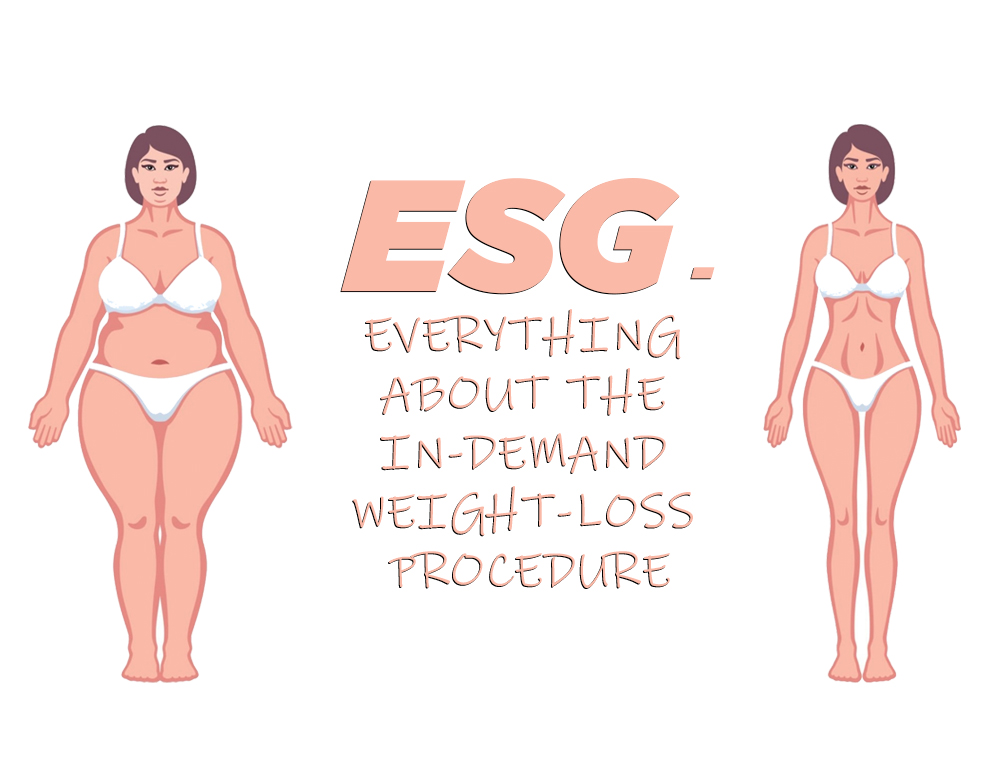No products in the cart.

ESG – Everything About the In-demand Weight-Loss Procedure
ESG Intro – Recently, K’s reality show sisters are in the news again. This time for a reason that has nothing to do with their shows but their personal lives. This time the news is about Kim’s drastic weight loss. Hmmm… these sisters never stop giving fashionistas all over the world goals.
Rumour has it that Kim has undergone a body-enhancing surgery that is the latest innovation in weight-loss surgeries across the world. This surgery is said to be an alternative to the manual route of losing weight-loss even if you are not overweight, or obese but just want to shed a few inches here and there. Talk about the solution to my worst nightmares!!! Stubborn abdominal fat! But is this true? Trust us to bring you the real gist of these procedures and any information on how to bring out the best in your everyday ensemble in words of David Eisenhower, “There are three stages of life: youth, maturity, and ‘My, you’re looking good!’” As a fashionista, you must be informed, if not we have failed. But I digress.
Well, assume all you want, these results from the two Kardashian sisters were the product of strict dieting, there are some speculations that the treatment may have been (ESG ) Endoscopic Sleeve Gastroplasty, a type of bariatric surgery. Not familiar with it? Join the queue. In terms of weight-loss surgery, this minimally invasive method is very new; it has only been utilized for a few years shy of eight years. Furthermore, it’s strictly carried out on perfectly healthy individuals with “normal” BMIs, not only those who are overweight, unlike pretty much any bariatric surgery you’ve ever heard of.
Here is the gist.
What is Endoscopic Sleeve Gastroplasty (ESG)?
ESG is also known as the accordion treatment. It is a weight-loss operation that shrinks the size of your stomach using an endoscopic suturing tool hence the reason it is a minimally invasive procedure. Without requiring full invasive surgery, the technique mimics what would happen with a surgical sleeve gastrectomy. The procedure is a more recent form of less invasive weight-loss therapy. A suturing tool is put into your neck and down to your stomach, and the endoscopist will sew your stomach to reduce its size. If diet and exercise haven’t helped you lose weight and you’re considerably overweight (body mass index of 30 or more), this treatment could be a possibility.
Weight reduction with endoscopic sleeve gastroplasty is considerable. It works in weight loss by largely reducing the amount of food you can consume per meal. Add that to the right eating habits and increased physical activities and boom… the result is remarkable! Additionally, because the surgery is less invasive, there is a lower chance of postoperative problems and a quicker return to normal activities.
Best Candidate For ESG?
ESG is an option for obese people who have tried diet and exercise but failed to lose the weight they wanted or who are just too conscious of how their body looks. No particular weight or body mass index (BMI) is necessary for the surgery, however, the majority of patients will fall within the range of 30 to 40 BMI. Consider yourself suitable if you have a body mass index of 30 to 40 and have tried usual weight-loss treatments with little or no success, or those who have a body mass index of 40 but dealing with stubborn abdominal fat and do not want surgery. A reduced stomach with intense physical activity is likely to trigger fat-burning of stored glycogen.
This operation has been carried out on individuals with higher BMIs who don’t want to pursue surgical procedures, nevertheless. Only 1% of patients who are qualified for bariatric [weight-loss] surgery do so, claims Dr. Steven Batash. However, endoscopic sleeve gastroplasty is not appropriate for all obese people. Hence consultations with the practitioner before the procedure is necessary. Doctors use a screening approach to determine whether the operation would be helpful for you. Additionally, you must be prepared to adopt a commitment to behavioural therapy, a healthy lifestyle change, and regular medical checkups.
Anyone with a significant hiatal hernia or a condition like gastritis or peptic ulcer disease, which is linked to gastrointestinal bleeding, should not undergo endoscopic sleeve gastroplasty.
Advantages of ESG
- Little or no scars nor incisions
- The normal digesting process is not changed.
- Possibility of a suppressed appetite
- Cheaper than gastric sleeve surgery overall
- Just by shrinking the stomach by 70% to 80%, the treatment enables patients to lose a large amount of weight without surgery. After a year, patients report a typical loose of 18% to 20% of their total body weight.
- Although (ESG) Endoscopic Sleeve Gastroplasty is meant to be permanent, surgery is reversible. No part of your stomach is removed, unlike gastric sleeve surgery.
- There is no need to remain overnight because ESG is an outpatient procedure.
- There are no incisions or scars because the operation is done via an endoscope. The likelihood of post-operative problems like infection is greatly decreased by the absence of incisions.
- ESG is less dangerous than gastric sleeve surgery and has fewer negative side effects.
- Another unrelated health benefit is that ESG can be carried out at an earlier stage and at a lower BMI than bariatric surgery, which is often only an option for those with a BMI of at least 35 who also have particular serious health issues (such type 2 diabetes, high blood pressure, or sleep apnea). This implies that more individuals can receive the care they require before their weight rises and comorbidities manifest or worsen.
What is the ESG Recovery Time?
After ESG, convalescence time is essentially nonexistent. After the treatment, you’ll be urged to stand up and move around to improve blood flow to the legs and prevent blood clots; however, strenuous activity is not recommended for the first few weeks.
For the first month, you must alter your eating habits:
Week 1: You can begin a low-sugar clear-liquid diet four hours following your treatment. The first week of this diet will need your commitment.
Week two: Your diet will change to one that consists of anything you can blend with a fork, or “soft food.” Choose low-fat, low-sugar, high-protein meals like eggs, and beans, that provide between 12 and 20 grams of protein per serving.
ESG seems to be safe, efficient and well accepted. The first 18 months are marked by considerable weight loss without significant fatality or sickness. During the first year after surgery, some individuals need review or correction. In the days after the treatment, abdominal discomfort or nausea are frequent side effects reported. A 2018 research of 1,000 patients found that 92.4% of them experienced these adverse effects after surgery. The great majority of both resolve within the first week and are both treated with medicine.
In conclusion, like any other weight reduction operation, (ESG) Endoscopic Sleeve Gastroplasty calls for the patient’s complete dedication to making significant dietary and lifestyle changes. In addition to eating a balanced diet, you should think about exercising frequently and staying active. A smaller stomach can cause you to feel full more quickly, plus it’s always best to avoid feeling too full or overeating. It all comes down to knowing what your body genuinely requires. To regulate your portion sizes and develop the habit of just eating what you truly need. Avoid drinking when you eat since it will cause your stomach to expand. Instead, eat gently.
In addition to eating a balanced whole life turn-around, don’t forget it takes a full year of commitment to see real lasting results. So, you must be ready for the long haul. One way to stay motivated is to get your trusty quality shapewear, body-shaper and waist-cinchers. They will help you stay snatched up and give you a continual picture of your target look each time you glam up.







Leave a Reply